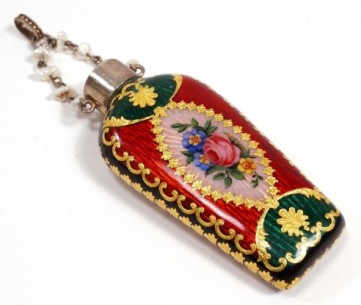 We humans love surprises, secrets, the mystique of hidden treasure and sudden delights to the senses; it is little wonder, then, that the miniature and wearable perfume bottles of old hold such thrill and fascination for their collectors.
We humans love surprises, secrets, the mystique of hidden treasure and sudden delights to the senses; it is little wonder, then, that the miniature and wearable perfume bottles of old hold such thrill and fascination for their collectors.
While many of those heavily invested in collecting antique perfume bottles focus on the large (and obviously splendid) pieces of great names like Lalique, there is a small faction of the hobby that is devoted to the quirky minutiae—those tiny, hard-to-find trinkets whose makers often remain entirely unknown.
History of Miniature Perfume Bottles
While portable perfumes can be traced back to ancient times, the popularity of miniature perfume containers became truly widespread during the 17-1800s, mostly in the following two forms:
 Vinaigrettes: Vinaigrettes (a strongly scented form of perfume distilled in vinegar) were carried everywhere both to mask body odour and to ward off germs. The fear of disease at the time was at a historical peak owing to the plague, tuberculosis, and a multitude of other serious pestilences that had rocked humanity and continued to pop up frequently in the various slums of Europe. As it was thought that illnesses were spread by foul air, both men and women had taken to carrying potent perfumes around with them in tiny sterling silver cases, with women often hanging theirs from their chatelaines (ornamental accessories which hooked to the waistband of dresses and generally had chains dangling from them).
Vinaigrettes: Vinaigrettes (a strongly scented form of perfume distilled in vinegar) were carried everywhere both to mask body odour and to ward off germs. The fear of disease at the time was at a historical peak owing to the plague, tuberculosis, and a multitude of other serious pestilences that had rocked humanity and continued to pop up frequently in the various slums of Europe. As it was thought that illnesses were spread by foul air, both men and women had taken to carrying potent perfumes around with them in tiny sterling silver cases, with women often hanging theirs from their chatelaines (ornamental accessories which hooked to the waistband of dresses and generally had chains dangling from them).
Over time, these wearable perfume dispensers became more specific to women (and began to also appear in the form of tiny bottles that were similarly hung from chatelaines); by the 1820s they were an almost exclusively female accessory and served the double purpose of reviving women who had fainted. As the role of the vinaigrette became more one of fashion than function, it eventually fell out of favour for no longer being trendy enough; by the mid-1800s, vinaigrettes were associated with only matrons and dowagers, forever becoming a thing of the past.
 Perfume Etuis: Unlike vinaigrettes, Perfume etuis* contained “true” much more expensive and fashionable perfume associated with the upper classes. The French aristocracy was so fond of it that the court of Louis XV became known as “la cour parfumée”. Perfume etuis were breathtaking little works of art, being composed of small perfume bottles housed in intricately detailed pocket-sized cases. These cases were often covered in tortoise shell, enamel, sterling silver, or shagreen (the skin of a shark or ray), or some combination of these materials, elaborately wrought, gilded, and painted into innumerable designs.
Perfume Etuis: Unlike vinaigrettes, Perfume etuis* contained “true” much more expensive and fashionable perfume associated with the upper classes. The French aristocracy was so fond of it that the court of Louis XV became known as “la cour parfumée”. Perfume etuis were breathtaking little works of art, being composed of small perfume bottles housed in intricately detailed pocket-sized cases. These cases were often covered in tortoise shell, enamel, sterling silver, or shagreen (the skin of a shark or ray), or some combination of these materials, elaborately wrought, gilded, and painted into innumerable designs.
*Etuis were made to house a number of small objects (known then as “necessaires”), such as tiny sewing kits and writing kits; the specific form of etuis that contains tiny perfume bottles is therefore known as a “perfume etui”.
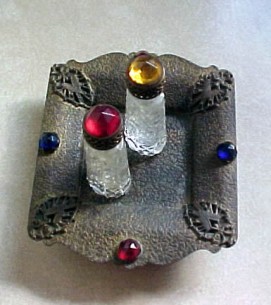 As the style of clothing changed, so did the style of miniature perfume bottles, but they remained popular in various forms all throughout the Victorian era and even into the 20th century. Small Victorian perfume containers were often ingenious, with tiny vials of perfume appearing on necklaces, perfume being hidden in brooches or rings, and (as you will see below) even around the frame of a tiny magnifying glass or as part of an impossibly tiny tray set. Sadly, most of these small novelties remain unmarked, but they are nonetheless an invaluable part of the history of perfume bottles:
As the style of clothing changed, so did the style of miniature perfume bottles, but they remained popular in various forms all throughout the Victorian era and even into the 20th century. Small Victorian perfume containers were often ingenious, with tiny vials of perfume appearing on necklaces, perfume being hidden in brooches or rings, and (as you will see below) even around the frame of a tiny magnifying glass or as part of an impossibly tiny tray set. Sadly, most of these small novelties remain unmarked, but they are nonetheless an invaluable part of the history of perfume bottles:
 Perfume magnifier (maker unknown): This little magnifying glass is set in a gold bezel that is cleverly surrounded by a glass perfume bottle; by the look of the small ring fitted to it, this piece was likely meant to hang from a chain draped from a chatelaine.
Perfume magnifier (maker unknown): This little magnifying glass is set in a gold bezel that is cleverly surrounded by a glass perfume bottle; by the look of the small ring fitted to it, this piece was likely meant to hang from a chain draped from a chatelaine.
- Irice perfume bottles with tray: This little set of two perfume bottles (with daubers and filigree design) features bottles that are just 2 and a half inches tall, on a tray that is only 4 inches wide.
- “Jewelled” Czech Perfume Bottle (maker unknown): This little bottle—just 2 inches tall—is one of the many wonders of ancient Bohemia, featuring ornate filigree, enamel detail, and glass “jewels”.
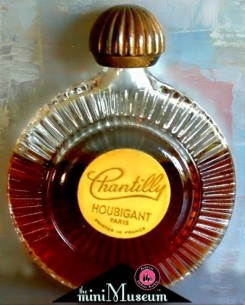 The era of the elegant handbag saw something of a revival for miniature perfume bottles (after the Art Nouveau/Art Deco-era craze for full-sized decorative bottles by Lalique et al) as women faced having to store everything they needed to carry with them in a small clutch; two of the most iconic of these small bottles are shown below:
The era of the elegant handbag saw something of a revival for miniature perfume bottles (after the Art Nouveau/Art Deco-era craze for full-sized decorative bottles by Lalique et al) as women faced having to store everything they needed to carry with them in a small clutch; two of the most iconic of these small bottles are shown below:
- Chantilly by Houbigant: Chantilly has been sold in many forms over the years, but this lovely little example from its original launch (1941) was obviously designed to easily slip into a little purse.
- Chanel Number 5: Chanel Number 5 was often sold in miniature form, as a much smaller replica of its signature bottle. During the 1940s-1960s Chanel bottles could sometimes be found in graduated sets of three, with bottles ranging from large to small sold in beautiful fitted leather cases.
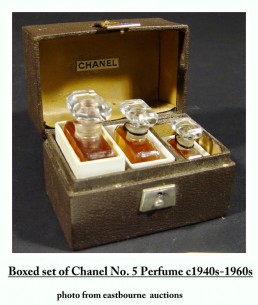
Why Collect Miniature Perfume Bottles?
The reasons why some people prefer to collect miniature perfume bottles as opposed to their full-sized counterparts are as diverse as the collectors themselves; some are simply fascinated with small, intricate curiosities from eras gone by, and others are drawn in by the practicality aspect: These bottles often go at auction for less than their larger brethren (with the exception of very old and/or rare makes), and they take considerably less space to store, a real bonus for those who don’t have entire rooms to devote to their collection.
Whatever one’s reason for collecting these tiny treasures, it’s impossible to deny there is something truly unique and intimate about these collectibles—they were, in many cases, not mere decoration for a vanity or dresser, but a part of daily life, something people kept close to themselves as they celebrated triumphs and endured trials; perhaps it is this emotional weight, the joys and sorrows of those long past, which makes these little bottles feel so priceless to us today.

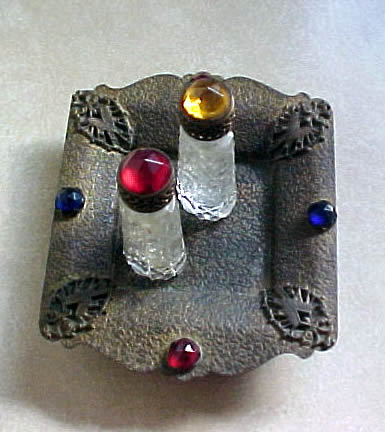
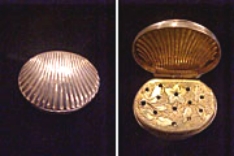 Vinaigrettes: Vinaigrettes (a strongly scented form of perfume distilled in vinegar) were carried everywhere both to mask body odour and to ward off germs. The fear of disease at the time was at a historical peak owing to the plague, tuberculosis, and a multitude of other serious pestilences that had rocked humanity and continued to pop up frequently in the various slums of Europe. As it was thought that illnesses were spread by foul air, both men and women had taken to carrying potent perfumes around with them in tiny sterling silver cases, with women often hanging theirs from their chatelaines (ornamental accessories which hooked to the waistband of dresses and generally had chains dangling from them).
Vinaigrettes: Vinaigrettes (a strongly scented form of perfume distilled in vinegar) were carried everywhere both to mask body odour and to ward off germs. The fear of disease at the time was at a historical peak owing to the plague, tuberculosis, and a multitude of other serious pestilences that had rocked humanity and continued to pop up frequently in the various slums of Europe. As it was thought that illnesses were spread by foul air, both men and women had taken to carrying potent perfumes around with them in tiny sterling silver cases, with women often hanging theirs from their chatelaines (ornamental accessories which hooked to the waistband of dresses and generally had chains dangling from them).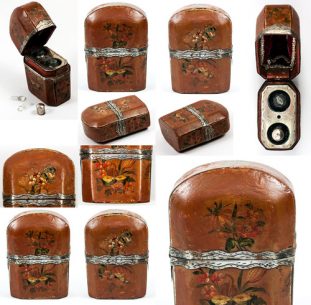 Perfume Etuis: Unlike vinaigrettes, Perfume etuis* contained “true” much more expensive and fashionable perfume associated with the upper classes. The French aristocracy was so fond of it that the court of Louis XV became known as “la cour parfumée”. Perfume etuis were breathtaking little works of art, being composed of small perfume bottles housed in intricately detailed pocket-sized cases. These cases were often covered in tortoise shell, enamel, sterling silver, or shagreen (the skin of a shark or ray), or some combination of these materials, elaborately wrought, gilded, and painted into innumerable designs.
Perfume Etuis: Unlike vinaigrettes, Perfume etuis* contained “true” much more expensive and fashionable perfume associated with the upper classes. The French aristocracy was so fond of it that the court of Louis XV became known as “la cour parfumée”. Perfume etuis were breathtaking little works of art, being composed of small perfume bottles housed in intricately detailed pocket-sized cases. These cases were often covered in tortoise shell, enamel, sterling silver, or shagreen (the skin of a shark or ray), or some combination of these materials, elaborately wrought, gilded, and painted into innumerable designs.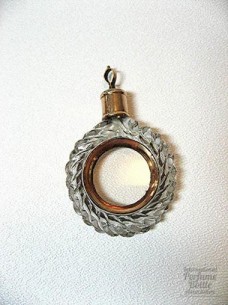 Perfume magnifier (maker unknown): This little magnifying glass is set in a gold bezel that is cleverly surrounded by a glass perfume bottle; by the look of the small ring fitted to it, this piece was likely meant to hang from a chain draped from a chatelaine.
Perfume magnifier (maker unknown): This little magnifying glass is set in a gold bezel that is cleverly surrounded by a glass perfume bottle; by the look of the small ring fitted to it, this piece was likely meant to hang from a chain draped from a chatelaine.